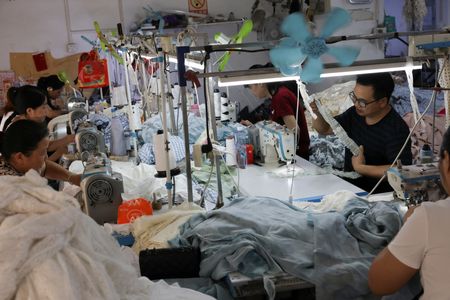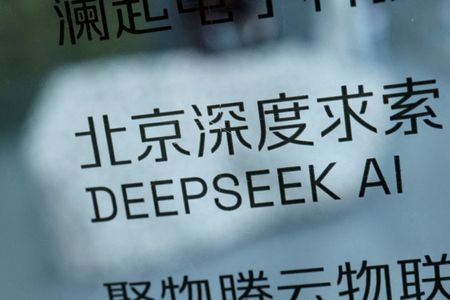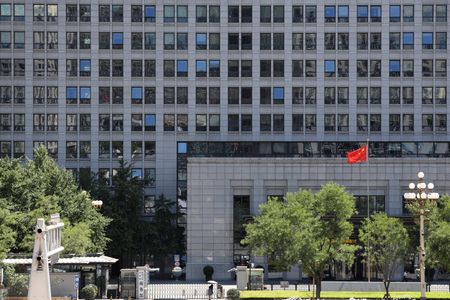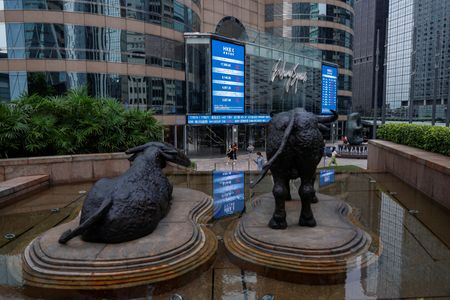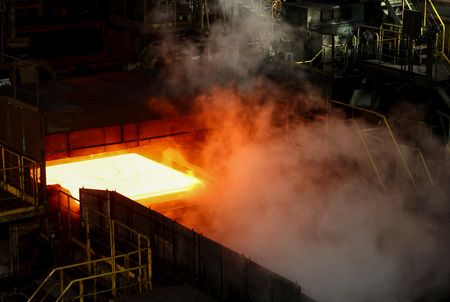By Tina Qiao, Ellen Zhang and Ryan Woo
BEIJING (Reuters) -China’s factory output slowed in April but showed surprising resilience, a sign that government support measures may have cushioned the impact of a trade war with the U.S. that threatens to derail momentum in the world’s second-largest economy.
Industrial output grew 6.1% from a year earlier, National Bureau of Statistics (NBS) data showed on Monday, slowing from 7.7% in March but beat a forecast 5.5% rise in a Reuters poll.
“April’s resilience is in part a result of ‘frontloaded’ fiscal support,” said Tianchen Xu, senior economist at the Economist Intelligence Unit, referring to stronger government spending.
The data followed firmer-than-expected exports earlier this month that economists said were supported by exporters rerouting shipments and countries buying more materials from China amid a re-ordering of global trade due to U.S. President Donald Trump’s tariffs.
However, Monday’s data underscored the shock from U.S. reciprocal tariffs, Xu said, adding “despite the rapid growth in industrial value-added, the export delivery value was nearly stagnant.”
Beijing and Washington reached a surprise agreement last week to roll back most tariffs imposed on each other’s goods since early April. The 90-day pause has put the brakes on a trade war that has disrupted global supply chains and stoked recession fears.
“China’s foreign trade has overcome difficulties and maintained steady growth, demonstrating strong resilience and international competitiveness,” Fu Linghui, statistics bureau spokesperson, told a press conference on Monday. He added that the trade de-escalation would benefit bilateral trade growth and global economic recovery.
But economists have warned that the short-term truce and U.S. President Donald Trump’s unpredictable approach will continue to cast a shadow over China’s export-driven economy, which still faces 30% tariffs on top of existing duties.
By midday, China’s blue-chip CSI300 Index dropped 0.4% and the Shanghai Composite Index lost 0.1%. The yuan currency also slipped against the dollar.
PRESSURES REMAIN
The property sector has yet to show signs of recovery, with home prices stagnating and investment in the sector shrinking.
Retail sales, a measure of consumption, rose 5.1% in April, down from a 5.9% increase in March, and missed forecasts for a 5.5% expansion. Economists attributed the slowdown to the impact of U.S. tariffs on consumer expectations and tepid demand at home.
Commodity sectors also showed signs of weakness with the country’s daily crude oil processing rate down 4.9% in April from March, while crude steel output slid 7% month-on-month.
Meanwhile, the government’s push to boost household spending via a trade-in scheme for consumer goods led to a 38.8% gain in home appliance sales.
The NBS data also showed the unemployment rate fell to 5.1% from 5.2% in March. But anecdotal evidence showed that some factories heavily reliant on the U.S. market have sent their workers home.
With persistent deflationary pressures and worse-than-expected bank lending data, economists highlighted the need for more policy support to foster a sustainable recovery.
“We caution that the near-term growth strength is at the cost of payback effects later and believe more policy easing is necessary to stabilise growth, employment and market sentiment,” Goldman Sachs economists said in a note.
China’s economy expanded 5.4% in the first quarter, exceeding expectations. Authorities remain confident of achieving Beijing’s growth target of around 5% this year, despite warnings from economists that U.S. tariffs could derail this momentum.
Alarmed by how tariffs have hurt economic activity, authorities earlier this month announced a package of stimulus measures, including interest rate cuts and a major liquidity injection.
The monetary easing measures were announced before the China-U.S. trade detente was reached after high-stakes talks in Geneva, marking a significant de-escalation from months of mounting tensions.
The U.S.-China “deal” agreed at the start of last week will provide some relief, said Julian Evans-Pritchard, head of China Economics at Capital Economics, “but even if the tariff rollback proves durable, wider headwinds mean that we still expect China’s economy to slow further over the coming quarters.”
“We suspect that the trade war has made households more concerned about their job prospects and therefore more careful about their spending.”
(Reporting by Tina Qiao, Ellen Zhang, Ethan Wang and Ryan Woo; Editing by Jacqueline Wong)

